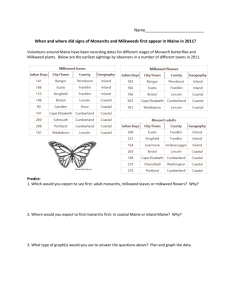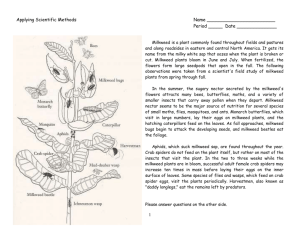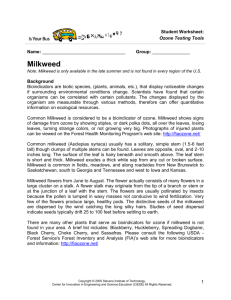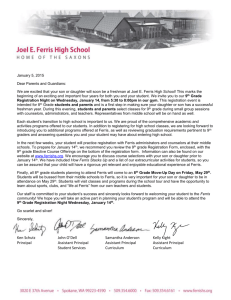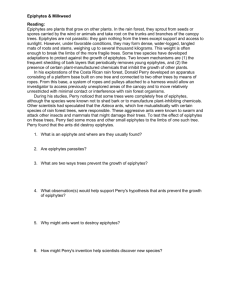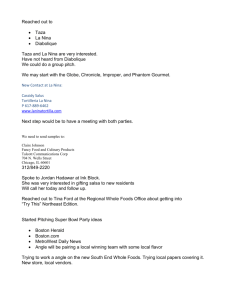Silhouettes of the D..
advertisement
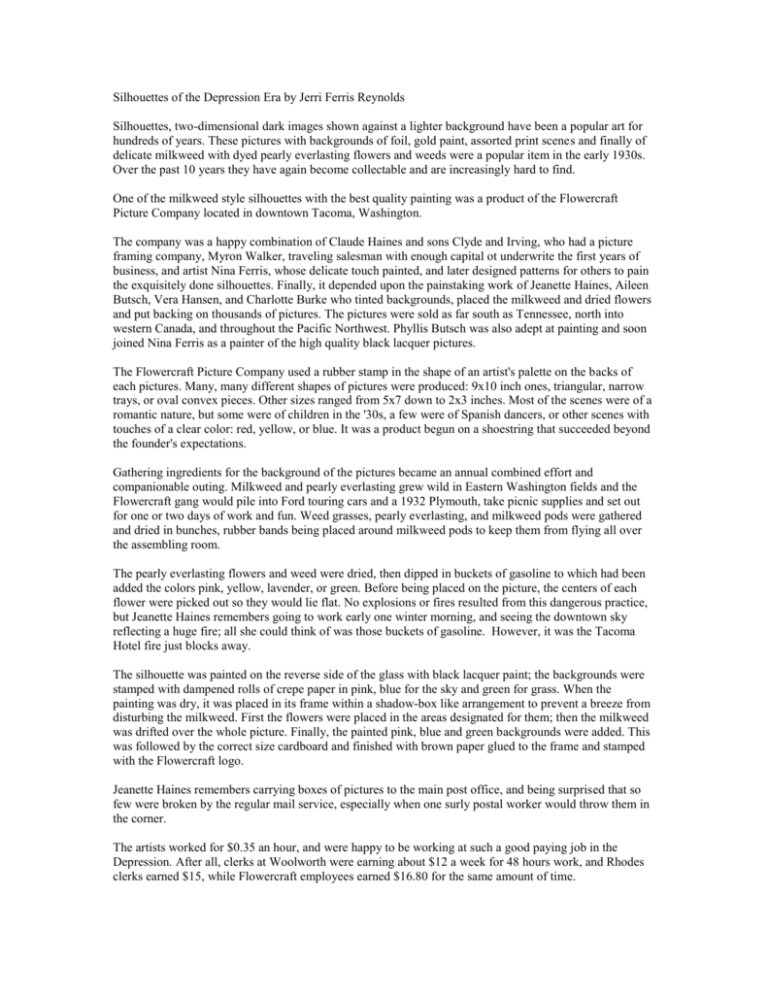
Silhouettes of the Depression Era by Jerri Ferris Reynolds Silhouettes, two-dimensional dark images shown against a lighter background have been a popular art for hundreds of years. These pictures with backgrounds of foil, gold paint, assorted print scenes and finally of delicate milkweed with dyed pearly everlasting flowers and weeds were a popular item in the early 1930s. Over the past 10 years they have again become collectable and are increasingly hard to find. One of the milkweed style silhouettes with the best quality painting was a product of the Flowercraft Picture Company located in downtown Tacoma, Washington. The company was a happy combination of Claude Haines and sons Clyde and Irving, who had a picture framing company, Myron Walker, traveling salesman with enough capital ot underwrite the first years of business, and artist Nina Ferris, whose delicate touch painted, and later designed patterns for others to pain the exquisitely done silhouettes. Finally, it depended upon the painstaking work of Jeanette Haines, Aileen Butsch, Vera Hansen, and Charlotte Burke who tinted backgrounds, placed the milkweed and dried flowers and put backing on thousands of pictures. The pictures were sold as far south as Tennessee, north into western Canada, and throughout the Pacific Northwest. Phyllis Butsch was also adept at painting and soon joined Nina Ferris as a painter of the high quality black lacquer pictures. The Flowercraft Picture Company used a rubber stamp in the shape of an artist's palette on the backs of each pictures. Many, many different shapes of pictures were produced: 9x10 inch ones, triangular, narrow trays, or oval convex pieces. Other sizes ranged from 5x7 down to 2x3 inches. Most of the scenes were of a romantic nature, but some were of children in the '30s, a few were of Spanish dancers, or other scenes with touches of a clear color: red, yellow, or blue. It was a product begun on a shoestring that succeeded beyond the founder's expectations. Gathering ingredients for the background of the pictures became an annual combined effort and companionable outing. Milkweed and pearly everlasting grew wild in Eastern Washington fields and the Flowercraft gang would pile into Ford touring cars and a 1932 Plymouth, take picnic supplies and set out for one or two days of work and fun. Weed grasses, pearly everlasting, and milkweed pods were gathered and dried in bunches, rubber bands being placed around milkweed pods to keep them from flying all over the assembling room. The pearly everlasting flowers and weed were dried, then dipped in buckets of gasoline to which had been added the colors pink, yellow, lavender, or green. Before being placed on the picture, the centers of each flower were picked out so they would lie flat. No explosions or fires resulted from this dangerous practice, but Jeanette Haines remembers going to work early one winter morning, and seeing the downtown sky reflecting a huge fire; all she could think of was those buckets of gasoline. However, it was the Tacoma Hotel fire just blocks away. The silhouette was painted on the reverse side of the glass with black lacquer paint; the backgrounds were stamped with dampened rolls of crepe paper in pink, blue for the sky and green for grass. When the painting was dry, it was placed in its frame within a shadow-box like arrangement to prevent a breeze from disturbing the milkweed. First the flowers were placed in the areas designated for them; then the milkweed was drifted over the whole picture. Finally, the painted pink, blue and green backgrounds were added. This was followed by the correct size cardboard and finished with brown paper glued to the frame and stamped with the Flowercraft logo. Jeanette Haines remembers carrying boxes of pictures to the main post office, and being surprised that so few were broken by the regular mail service, especially when one surly postal worker would throw them in the corner. The artists worked for $0.35 an hour, and were happy to be working at such a good paying job in the Depression. After all, clerks at Woolworth were earning about $12 a week for 48 hours work, and Rhodes clerks earned $15, while Flowercraft employees earned $16.80 for the same amount of time. The original company lasted into the early '40s, when it moved on to silk screening the patterns, which left a somewhat ragged edge to the discerning eye. Nina Ferris left Flowercraft in the early '40s to work for Richards, a well-known photographic studio in Tacoma. Unfortunately, Nina Ferris kept none of her hand painted silhouettes, so her family has scrounged flea markets, collectable booths in antique malls, and garage sales to find them. So far, we hae discovered about 15 different types of pictures. After seeing hundreds of different styles of silhouettes of the '30s, we fell that Nina Ferris's work represents the top of the line. Before she died in 1982, she was able to enjoy the resurgence of the silhouette picture. "Just think!" she would say, "I am a collectable in my own time." Indeed she was, and has so remained.
